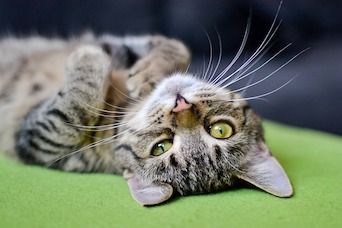Could Cats Help Solve HIV Treatment Challenges?
HIV-1 treatment is frequently stymied by drug resistance, but a recent study of feline immunodeficiency virus could provide clues for overcoming this resistance.

A recent study published in PLoS Pathogens suggests how veterinary and human medicine can intersect to solve the persistent problem of drug resistance with AIDS treatment. For this study, an Israeli research team characterized the crystal structure of reverse transcriptase (RT), an enzyme that converts the viral RNA genome into DNA and is a frequent target for many anti-AIDS drugs.
RT is composed of two subunits that provide the enzyme with both rigidity (p51 subunit) and flexibility (p66 subunit). One structural component of RT, called the non-nucleoside binding pocket (NNBP), is targeted by the class of anti-AIDS drugs named non-nucleoside reverse transcriptase inhibitors (NNRTIs). However, RT can develop resistance mutations, stymying treatment successes with RT inhibitors.
RELATED:
- Study Reports the First Molecular Characterization of FIV in Mainland China
- Raising Hope: New Heart Disease Drug May Help Both Cats and People
Feline immunodeficiency virus (FIV), also known as feline AIDS, is resistant to NNRTI treatment. Previous studies have suggested that FIV’s rigid RT structure confers this resistance. Given this finding and the similarities in protein structure and function between FIV and HIV-1, FIV RT could be “an invaluable model for the study of HIV-1 RT resistance and drug development,” wrote the research team.
FIV RT Crystal Structure
Crystal structure analysis revealed that FIV RT’s conformational fold and NNBP architecture are conserved with HIV-1.
However, within the FIV RT crystal structure, the research team observed several genetic variances at the NNBP entryway that make the binding pocket more rigid and closed; this locked conformation provides an unfavorable binding environment for NNRTIs. In addition, some of these genetic variances could alter the entryway’s electrostatic environment, interfering with drug channeling, penetration, and binding.
Binding Affinity
After characterizing the FIV RT crystal structure, the research team evaluated the binding affinity of three NNRTIs—delavirdine, efavirenz, and rilpivirine—to FIV RT and HIV-1 RT. Delavirdine, a first-generation NNRTI, and efavirenz, a second-generation NNRTI, did not bind to FIV RT. Notably, rilpivirine, a second-generation NNRTI, bound with similar affinity to FIV RT and HIV-1 RT, suggesting its ability to “overcome the physiochemical barriers imposed by FIV RT variances at the pocket entryway,” the researchers wrote.
To further evaluate binding affinity, the researchers mutated the p51 loop of FIV RT to match that of HIV-1 RT. Binding affinities to the mutated FIV RT increased for each NNRTI, indicating that the mutation opened up the binding pocket’s entryway. However, this improved binding did not make the mutated FIV RT more sensitive to the NNRTIs. Further studies will be needed to determine how FIV RT can remain resistant to NNRTIs in the face of increased drug binding, the researchers noted.
Study Implications
The study’s findings highlight how cats can indeed help in the quest to overcome treatment resistance in AIDS cases. In particular, the closed binding pocket of wild-type FIV RT provides an avenue into developing new NNRTIs that can disrupt that pocket. The continued drug resistance with the open pocket of the mutated FIV RT provides a model for studying how HIV-1 “escapes” the effects of bound NNRTIs.
Dr. Pendergrass received her doctor of veterinary medicine degree from the Virginia-Maryland College of Veterinary Medicine. Following veterinary school, she completed a postdoctoral fellowship at Emory University’s Yerkes National Primate Research Center. Dr. Pendergrass is the founder and owner of JPen Communications, a medical communications company.